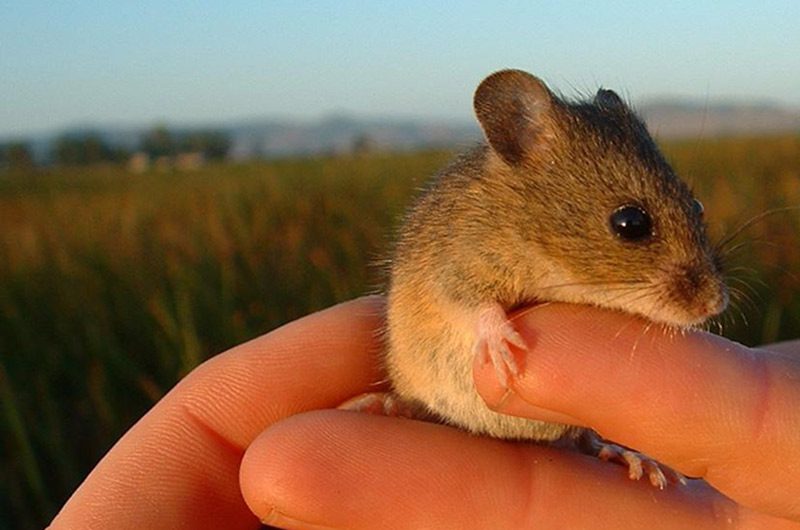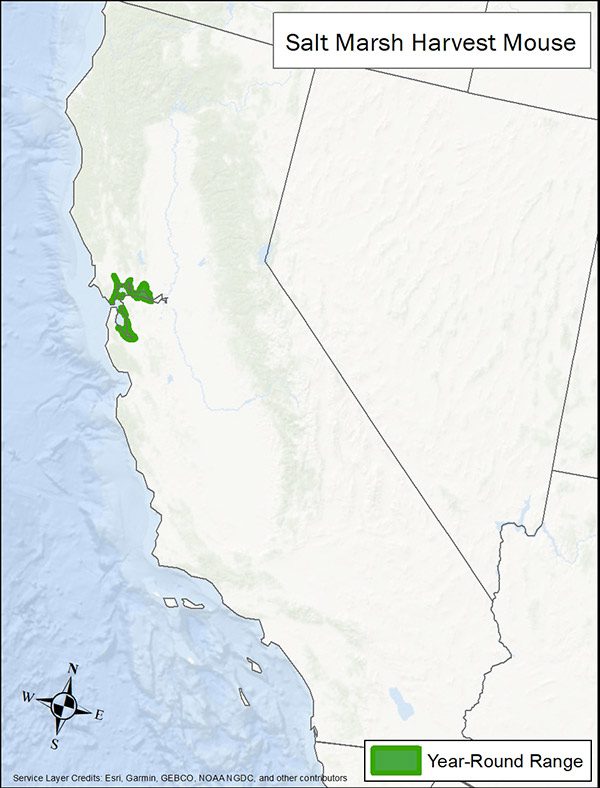LandPKS Learning
Habitat Hub

Salt Marsh Harvest Mouse
The salt marsh harvest mouse is well suited to tidal salt marshes as they can withstand high levels of salt in their food and water as well as having a strong ability to swim and climb.
Reithrodontomys raviventris
Identification
Salt marsh harvest mouse is a very small dark brown rodent measuring 2.75-3 in/7-8 cm and may have a dark stripe down its back. The salt marsh harvest mouse weighs 0.3-0.5 oz/9-14 g. The belly of this mouse is white, pinkish cinnamon or tawny. Salt marsh harvest mouse tail is usually one color unlike other mice that have a bicolored tail and is as long if not longer than its body and head. The upper incisors are grooved similar to other harvest mice. Salt marsh harvest mouse is Endangered in the United States and in California.
Observation Tips
Salt marsh harvest mice have two subspecies, a northern one found in marshes of San Pablo and Suisun Bay, and a southern one found in marshes of Corte Madera, Richmond and South San Francisco Bay. They are known from several accessible public protected areas including San Pablo Bay and San Francisco Bay National Wildlife Refuges. They are active year-round and primarily nocturnal making them somewhat hard to find. The salt march harvest mouse breeds in March through November with litters averaging 4 young.
Interesting Fact
The salt marsh harvest mouse is well suited to tidal salt marshes as they can withstand high levels of salt in their food and water as well as having a strong ability to swim and climb.
Ideal Habitat
Salt marsh harvest mice depend upon tidal marshes along the central coast of California. Salt marsh harvest mice eat leaves, seeds, and stems of plants preferring fresh green grasses in winter and pickleweed and saltgrass the rest of the year. These marshes ideally have dense stands of pickleweed with adjacent salt tolerant vegetation. Nests are a loose ball of grass or sedge on the ground. Adjacent areas are needed for salt marsh harvest mice to have places to go during extreme high tides and storms.

Range map provided by International Union for Conservation of Nature
Management Activities that Benefit Species – Best Management Practices (BMPs)
Maintain intact tidal marshes and allow tidal marshes to migrate to higher ground as sea level rises. Weed management should take an integrated approach. Weed species such as invasive cordgrass should be controlled because it does not provide adequate habitat for salt marsh harvest mice. Support restoration and invasive species management efforts by participating when possible. Control non-native predators including feral cats and foxes. Allow reintroduction of salt marsh harvest mice into unoccupied habitat.
Management Activities to Avoid
Avoid conversion and fragmentation of tidal marshes to cropland agriculture, urbanization, or aquaculture. Avoid diking or other infrastructure that alters the hydrology, salinity, and connection to adjacent upland escape areas.
Other Species that Benefit from Similar Habitat Management
Management for salt marsh harvest marsh will benefit other species that are dependent on salt marshes in central California including California clapper rail, California seablite (Suaeda californica), salt marsh bird’s beak (Chloropyon maritimum ssp. maritimum), salt marsh wandering shrew, Suisun shrew, San Pablo vole, California black rail, Alameda, Suisun, and San Pablo song sparrow subspecies, saltmarsh common yellowthroat, old man tiger beetle, delta tule pea, and Pacific cordgrass.
Download
Download the salt marsh harvest mouse Factsheet
Descarga la ficha de el ratón cosechero de la Bahía de San Francisco
Other Resources
International Union for Conservation of Nature (IUCN). 2014. The IUCN Red List of Threatened Species. Version 2021-1 Salt marsh harvest mouse
NatureServe. 2021. NatureServe Explorer: An online encyclopedia of life [web application]. Version 7.1. NatureServe, Arlington, Virginia. Salt marsh harvest mouse
US EPA. Endangered Species Facts Salt marsh harvest mouse
USFWS. Species Profile Salt marsh harvest mouse
USFWS. Recovery plan for tidal marshes ecosystems in Northern and Central California.
Mobile App | Data Portal | Knowledge Hub | Habitat Hub | Learning Collections | Blog | About | Contact | Support



